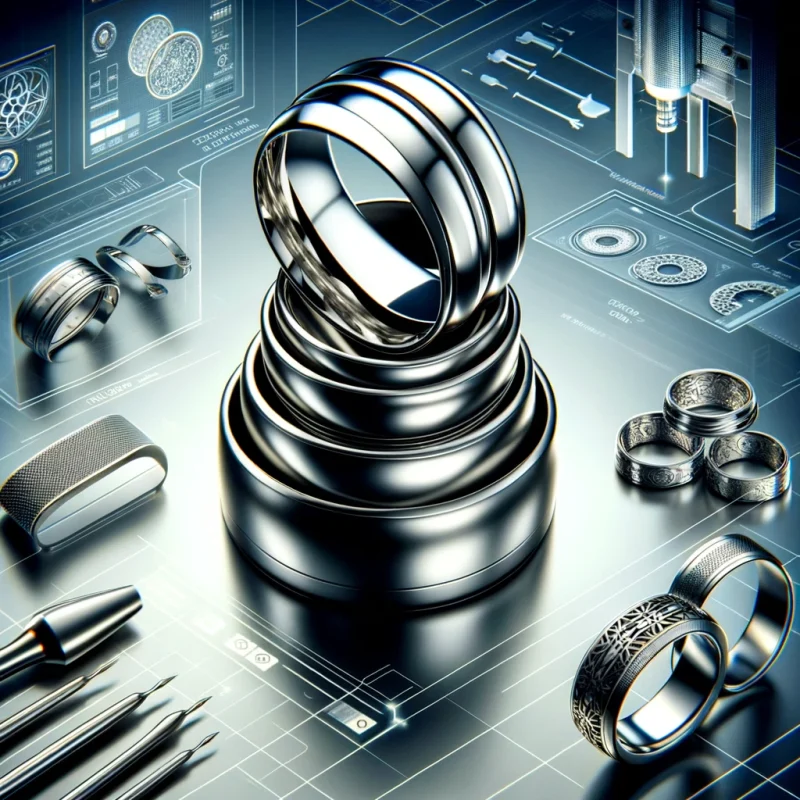Jewelry trends come and go, but some materials prove they have staying power.
One of the hottest materials shaking up the jewelry industry today is forged carbon fiber. This high-tech material, originally developed for use in the aerospace and automotive industries, has now made a striking entrance into the world of luxury accessories. It’s not just a fad; it’s a revolution. So why should retailers consider investing in forged carbon fiber jewelry now? Let’s dig in.
What’s So Special About Forged Carbon Fiber?
Forged carbon fiber is created by compressing fibers under heat and high pressure, resulting in a product that is incredibly strong, lightweight, and visually unique. Its durability and resistance to wear make it a perfect material for modern jewelry. Unlike traditional metals, forged carbon fiber won’t rust, tarnish, or corrode, making it an ideal option for consumers looking for long-lasting, stylish accessories.
Why the Rising Demand for Forged Carbon Fiber Jewelry?
In recent years, consumers have begun seeking out materials that align with their active lifestyles and personal aesthetics. Forged carbon fiber perfectly fits this need, offering both functionality and style. It’s lightweight, making it comfortable for all-day wear, and hypoallergenic, which is a major plus for those with sensitive skin. Additionally, as people become more eco-conscious, the use of carbon fiber—often produced using recycled materials—appeals to environmentally mindful buyers.
Rising Popularity of Carbon Fiber Jewelry
Retailers are increasingly recognizing the value of stocking forged carbon fiber jewelry, as it’s experiencing a sharp rise in demand. Why? Modern consumers, especially those interested in unique and high-performance materials, are drawn to its rugged aesthetic and cutting-edge appeal. Forged carbon fiber is not only incredibly strong, but also much lighter than traditional metals like gold and titanium.
This demand is being fueled by several factors. First, consumers love the distinctive, marbled appearance of forged carbon fiber, which gives each piece a one-of-a-kind look. Moreover, forged carbon fiber jewelry caters to a growing market of buyers who are after something durable yet lightweight—perfect for those who lead active lifestyles.
Why Retailers Should Jump on Board Now
With consumer interest in sustainable and high-tech materials growing, now is the perfect time for retailers to invest in forged carbon fiber jewelry. The material is often associated with innovation, given its use in aerospace and motorsports, and is now making waves in the luxury jewelry market. Retailers offering this jewelry are not just selling a product, but a conversation starter, as many pieces come with stories of how the material was originally used in high-performance environments.
In terms of profit potential, forged carbon fiber jewelry is relatively inexpensive to produce compared to gold or platinum, but can still command a premium price due to its modern, sleek look and perceived value. This allows retailers to offer attractive margins while still providing consumers with a top-tier product.
How Forged Carbon Fiber Jewelry Appeals to Modern Consumers
One of the most compelling reasons for retailers to stock forged carbon fiber jewelry is its distinct appeal to modern, trend-savvy consumers. Buyers today, especially in the millennial and Gen Z demographics, are seeking items that are more than just aesthetically pleasing—they want pieces that tell a story or embody high-tech innovation. Forged carbon fiber, with its origins in aerospace and automotive industries, provides that connection.
In addition, the lightweight nature of forged carbon fiber, combined with its durability, makes it an attractive choice for people with active lifestyles. Hypoallergenic properties and resistance to water or corrosion also make it an excellent option for those looking for everyday wear jewelry.
Customization and Flexibility in Design
For retailers, another huge advantage of investing in forged carbon fiber jewelry is its customization potential. This material can be easily combined with metals, woods, and even gemstones, giving designers the flexibility to create highly unique and personalized pieces. From mixing it with titanium for a futuristic feel to pairing it with reclaimed wood for an eco-friendly twist, the possibilities are nearly endless. This versatility is key, as consumers increasingly look for jewelry that reflects their personal values and style preferences.
Moreover, forged carbon fiber can be shaped and molded into sleek, minimalist designs or more elaborate, statement pieces, depending on the target market. Whether customers are after subtle sophistication or bold, edgy styles, forged carbon fiber can meet their needs.
Eco-Friendly Appeal of Forged Carbon Fiber Jewelry
Today’s consumers are more eco-conscious than ever, and sustainability is a significant driver behind purchasing decisions. Forged carbon fiber jewelry, while associated with high-tech materials, is also recognized for its potential to be environmentally friendly. Many carbon fiber products are made using recycled materials, making them a sustainable choice for those looking to reduce their carbon footprint.
This eco-friendly angle gives retailers an additional marketing edge. Customers are increasingly gravitating toward products that align with their values, and jewelry made from materials like forged carbon fiber, which can be created with minimal environmental impact, fits this trend perfectly. Some manufacturers have also begun experimenting with combining forged carbon fiber with reclaimed wood or other upcycled materials to further enhance their appeal to the eco-conscious consumer.
The Durability and Longevity Factor
When customers invest in high-end jewelry, they expect it to last—and that’s where forged carbon fiber shines. This material is known for its incredible strength-to-weight ratio, making it more durable than traditional materials like gold or silver. It’s nearly impossible to break, crack, or damage, even in harsh conditions. For those who lead active, outdoor lifestyles or who simply want a reliable, long-lasting piece, forged carbon fiber jewelry offers peace of mind.
Additionally, the corrosion resistance of forged carbon fiber means it won’t tarnish or rust over time, a major selling point compared to metal-based alternatives. This low-maintenance aspect makes it perfect for everyday wear, especially for consumers who don’t want to constantly worry about their jewelry’s condition.
How Retailers Can Market Forged Carbon Fiber Jewelry
For retailers, forged carbon fiber isn’t just another material—it’s a lifestyle product. To maximize the appeal of these pieces, it’s essential to highlight their unique qualities and the stories behind them. Here’s how to position this material effectively:
- Focus on the Innovation: Emphasize how forged carbon fiber originated in industries like aerospace and automotive, where performance and durability are paramount. Consumers love the idea of owning a piece of cutting-edge technology, especially in the form of luxury jewelry.
- Sustainability Matters: As mentioned earlier, eco-conscious marketing can greatly enhance consumer interest. Use terms like “recycled materials” or “sustainable sourcing” in product descriptions to appeal to green-minded shoppers.
- Stress Durability: For customers who are tired of replacing fragile jewelry, forged carbon fiber is a godsend. It offers outstanding strength, and because it’s resistant to wear and tear, buyers will feel they are making a long-term investment.
- Personalization: Customization is a powerful tool. Offering a range of forged carbon fiber pieces that can be tailored with other materials, like metals or wood, provides an opportunity for consumers to create jewelry that is deeply personal and meaningful.
Profit Margins and Pricing Strategies for Forged Carbon Fiber Jewelry
When it comes to profit margins, forged carbon fiber jewelry presents an excellent opportunity for retailers. The production costs of carbon fiber are relatively low compared to precious metals like gold and platinum, yet the material’s modern, high-tech appeal allows retailers to price it at a premium. Consumers are often willing to pay more for unique, innovative products, and forged carbon fiber, with its durability, lightweight feel, and sleek design, fits this category perfectly.
Pricing Strategies: How to Maximize Margins
- Premium Pricing for Limited Editions: Offering limited-edition collections or customizable options can justify higher price points. Unique combinations like carbon fiber with titanium, precious metals, or gemstones allow retailers to position the product as high-end while maintaining lower material costs. Additionally, pieces that incorporate glow rings or reclaimed wood tend to stand out in the market, further boosting their perceived value.
- Mid-Tier Pricing for Everyday Wear: For consumers looking for functional yet stylish everyday jewelry, forged carbon fiber can be marketed at a mid-tier price point. Highlighting the material’s low-maintenance and resistant properties ensures that buyers feel confident they’re investing in something durable. At the same time, this keeps the product accessible to a wider audience.
- Bundling and Upselling: Retailers can further increase profits by bundling carbon fiber rings with other accessories like bracelets or cufflinks. These bundles give customers the chance to complete their look while increasing the overall transaction value. Additionally, offering personalization options for rings, such as engraving or pairing with unique materials, is an effective way to upsell.
The Future of Forged Carbon Fiber Jewelry
With rising consumer interest in both sustainability and cutting-edge materials, the future of forged carbon fiber jewelry looks bright. This material is well-positioned to capture the attention of tech enthusiasts, eco-conscious consumers, and those seeking a modern aesthetic. As more designers experiment with creative combinations of carbon fiber and other materials like wood or metal inlays, its appeal will only grow.
Retailers that invest now in forged carbon fiber pieces are tapping into a trend that is set to expand in the coming years. By positioning this jewelry as both high-tech and eco-friendly, retailers can appeal to a broad spectrum of consumers while enjoying healthy profit margins and repeat business. The flexibility of the material and its growing appeal make it a sound investment for any retailer looking to stay ahead in the competitive jewelry market.


